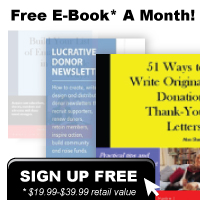In the last newsletter we extolled the virtues of long copy. This newsletter will go over a few design guidelines that will help ensure your long copy gets read. And that in a nutshell is the sole purpose of design in direct mail – to get the copy read. Design on its own does not sell. But it is critical because if it doesn’t do its job, the copy will not get read and response will suffer.
In general, design plays a very secondary role in fundraising. When you’re asking for money to support your cause, expensive looking packages may seem wasteful to the reader and convey the wrong impression.
On the whole, most of the same design rules that apply to all direct mail apply to fundraising. One major difference is that the format and the components are not as variable as in other direct mail. You will rarely see self-mailers, postcards, catalogs, magalogs or the like. They don’t work in fundraising because they don’t have the personal feeling and can’t trigger the emotional reaction that only an envelope mailing can provide.
And that’s why in fundraising the format is generally the traditional direct mail package – an outer envelope containing a letter, a reply device and a BRE (business reply envelope – postage paid) or CRE (courtesy reply envelope – postage not paid). Here are a few basic design guidelines for these components that will help maximize response:
White space: How to make your letter look easy to read
As in all direct mail, the letter is by far the most important element. It does the main job of selling. You have to design your letter so that it looks like it will be easy to read. And that means for starters, your letter should have lots of white space. Nothing turns a reader off like staring at a page that is dense with type. It looks like a challenge and hard work so they don’t even begin to read.
To create that spacious look your letter should follow the same basic rules as in other direct mail letters, such as:
- Short sentences and short paragraphs. Long sentences and long paragraphs will give you that dense look you want to avoid. I try to keep my paragraphs no longer than 3 lines, 5 at most. And sometimes for emphasis, the paragraph may be only 1 line.
- Indented paragraphs. Again, this will give you a little more of that vital white space.
- At least a 1.25″ margin on the sides of an 8 ½ x 11 page. Again, more white space
- Double space between paragraphs. This again creates more white space for easier readability.
7 design tips for your fundraising letter
- Use black ink. Blue ink may be pretty but black ink is easier to read and it is what people are used to.
- Use a serif typeface. Designers often like to use a sans-serif face because it is cleaner and more modern. And that may be true but a serif face is more readable. Case closed.
- Underlining is good but don’t use color, especially don’t use red – it’s too much like “junk” mail. And don’t underline whole paragraphs – just key sentences and phrases. Remember, too much emphasis is no emphasis.
- One tactic worth testing is to use handwritten notes in the margin of the letter. Just make sure they’re in the same handwriting and the same ink color as the signature (preferably blue). And as with underlining, be careful not to overdo – use a maximum of 2 or 3 notes in a letter.
- Avoid all caps in the letter. All caps screams your message and screaming is not what you want to do in fundraising.
- Remember that people who give to non-profits are usually older, so keep type sizes a bit larger – no smaller than 11 point Times Roman, better is 12 or 13.
- Be careful not to look too expensive, especially with your choice of paper. Stick with inexpensive bond in white or near white color.




Leave a Reply